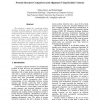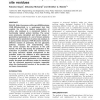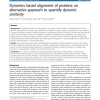23 search results - page 1 / 5 » Residue Contexts: Non-sequential Protein Structure Alignment... |
ISBRA
2010
Springer
13 years 2 months ago
2010
Springer
The study of non-sequential alignments, with different connectivity of the aligned fragments in the proteins being compared can offer a more complete picture of the structural, evo...
AINA
2008
IEEE
13 years 11 months ago
2008
IEEE
We introduce a method for comparing protein structures using the notion of residue contexts based on protein Cα-atom backbones. The residue context is derived from the set of vec...
BIBM
2010
IEEE
13 years 2 months ago
2010
IEEE
ATP is a ubiquitous nucleotide that provides energy for cellular activities, catalyzes chemical reactions, and is involved in cellular signaling. The knowledge of the ATPprotein in...
NAR
2007
13 years 4 months ago
2007
PAR-3D (http://sunserver.cdfd.org.in:8080/protease /PAR_3D/index.html) is a web-based tool that exploits the fact that relative juxtaposition of active site residues is a conserve...
BMCBI
2010
12 years 11 months ago
2010
Background: The dynamic motions of many proteins are central to their function. It therefore follows that the dynamic requirements of a protein are evolutionary constrained. In or...



